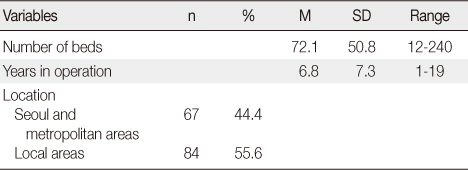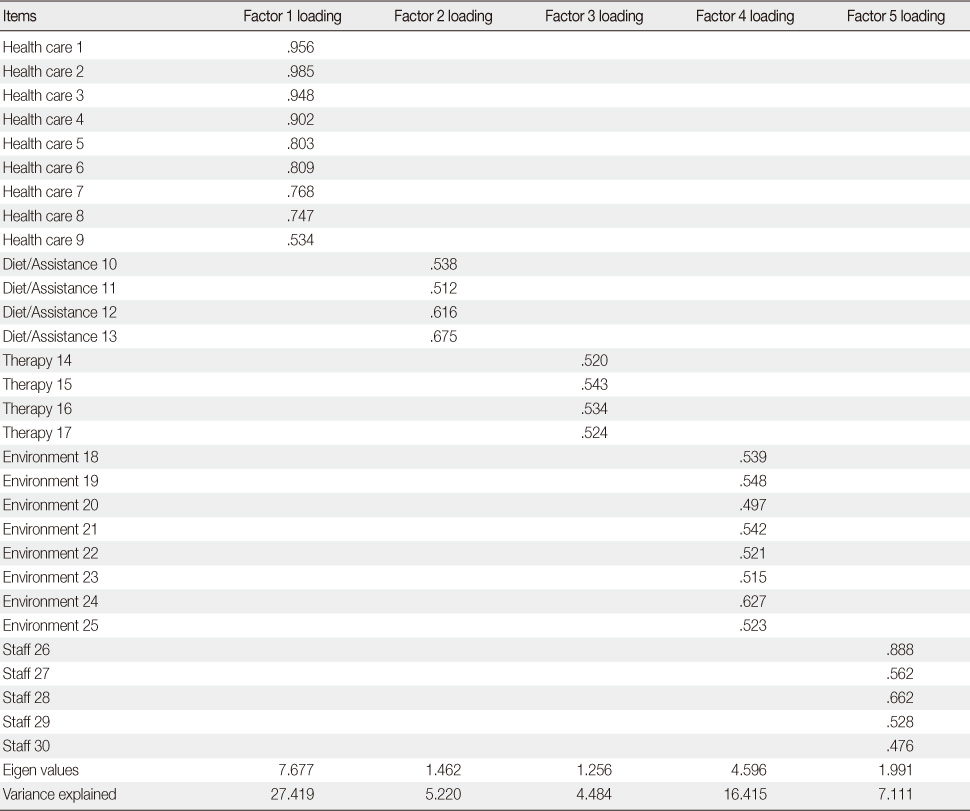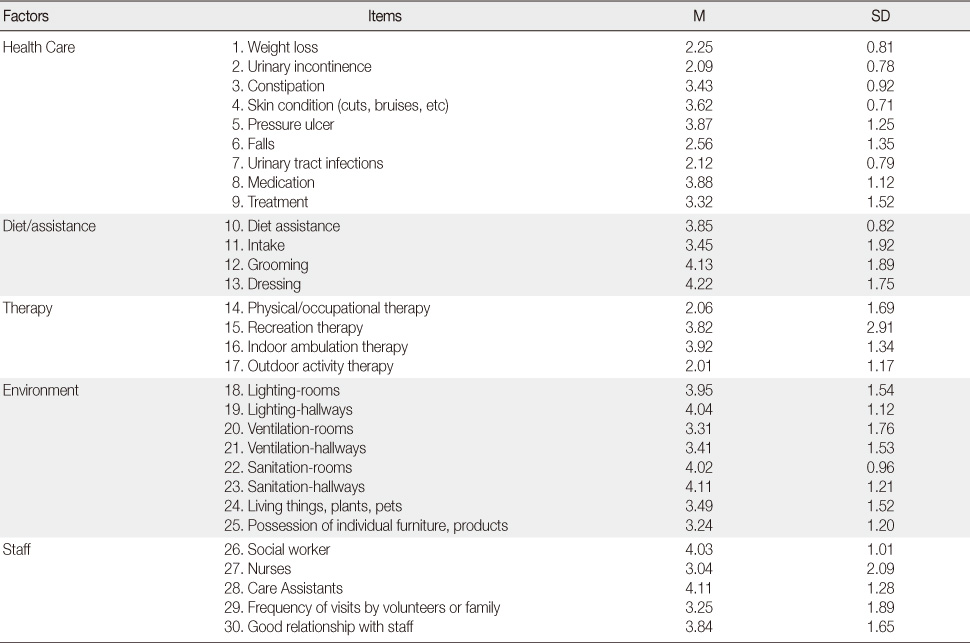Articles
- Page Path
- HOME > J Korean Acad Nurs > Volume 41(4); 2011 > Article
-
Original Article
- Development of an Evaluation Instrument for Service Quality in Nursing Homes
- Jia Lee, Eun Sun Ji
-
Journal of Korean Academy of Nursing 2011;41(4):510-519.
DOI: https://doi.org/10.4040/jkan.2011.41.4.510
Published online: August 31, 2011
1Associate Professor, College of Nursing Science, East-West Nursing Institute, Kyung Hee University, Seoul, Korea.
2Research Fellow, College of Nursing Science, Kyung Hee University, Seoul, Korea.
- Address reprint requests to: Lee, Jia. College of Nursing Science, Kyung Hee University, 1 Hoegi-dong, Dongdaemun-gu, Seoul 130-701, Korea. Tel: +82-2-961-0894, Fax: +82-2-961-9398, leejia@khu.ac.kr
• Received: April 20, 2010 • Accepted: August 4, 2011
© 2011 Korean Society of Nursing Science
- 464 Views
- 1 Download
- 3 Scopus
Abstract
-
Purpose
- The purposes of this study were to identify the factors influencing service quality in nursing homes, and to develop an evaluation instrument for service quality.
-
Methods
- A three-phase process was employed for the study. 1) The important factors to evaluate the service quality in nursing homes were identified through a literature review, panel discussion and focus group interview, 2) the evaluation instrument was developed, and 3) validity and reliability of the study instrument were tested by factor analysis, Pearson correlation coefficient, Cronbach's α and Cohen's Kappa.
-
Results
- Factor analysis showed that the factors influencing service quality in nursing homes were healthcare, diet/assistance, therapy, environment and staff. To improve objectivity of the instrument, quantitative as well as qualitative evaluation approaches were adopted. The study instrument was developed with 30 items and showed acceptable construct validity. The criterion-related validity was a Pearson correlation coefficient of .85 in 151 care facilities. The internal consistency was Cronbach's α=.95.
-
Conclusion
- The instrument has acceptable validity and a high degree of reliability. Staff in nursing homes can continuously improve and manage their services using the results of the evaluation instrument.
The work was supported by the Korea Research Foundation Grant funded by the Korea Government (MOEHRD, Basic Research Promotion Fund) (KRF-2007-E00289).
- 1. Bryant FB, Yarnold PR. Grimm LG, Yarnold PR. Principal components analysis and exploratory and confirmatory factor analysis. In: Reading and understanding multivariate statistics. 1995;Washington, DC, American Psychological Association. 99–136.
- 2. Five-star quality rating system. Center for Medicare and Medicaid Services. 2010;Retrieved March 25, 2010. from http://www.cms.gov/Certificationandcomplianc/13_FSQRS.asp.
- 3. Cho HS. Development of quality management index for Korean nursing homes. 2005;Seoul, Korea University. Unpublished doctoral dissertation.
- 4. Cronbach LJ, Richard JS. My current thoughts on coefficient alpha and successor procedures. Educational and Psychological Measurement. 2004;64:391–418. doi: 10.1177/0013164404266386.ArticlePDF
- 5. Hair JF, Black WC, Babin BJ, Anderson RE. Multivariate data analysis. 2009;7th ed. New York, Prentice Hall.
- 6. Hwang SC. Overview of service evaluation for the Korean elder facilities. Social Science Research. 2001;6:66–84.
- 7. Kim NH. A study on post occupancy evaluation of recent private elderly facility. 2006;Seoul, Yonsei University. Unpublished master's thesis.
- 8. Kim OS, Kim SS, Kim KO, Kim YA, Kim HS, Park JS, et al. The needs about paying nursing homes for elderly parents. Journal of Korean Gerontological Nursing. 2005;7:20–27.
- 9. Krueger RA. Focus groups: A practical guide for applied research. 1988;Newbury Park, CA, SAGE Publications.
- 10. Kwon JH. Quality management system of Japanese long-term care services. Health Insurance Forum. 2008;7:59–74.
- 11. Lee EO, Im NY, Park HA, Lee IS, Kim JI, Bae JE, et al. Nursing research and statistical analysis. 2009;Seoul, Soo Moon Sa.
- 12. Lee J. Validity and reliability of the Korean version of the observable indicators of nursing home care quality evaluation instrument. Journal of Korean Academy of Nursing. 2008;38:474–482.ArticlePubMed
- 13. Lee SH. The determinants of nursing home quality indicators: A multilevel analysis. 2006;Seoul, Ewha Womans University. Unpublished doctoral dissertation.
- 14. Lee YM. A study on service satisfaction of user's family in charged recuperation facility specialized on the old. 2002;Seoul, Chung-Ang University. Unpublished master's thesis.
- 15. Long-term care facility and increasing elder user status. Ministry for Health, Welfare and Family Affairs. 2007;Retrieved May 6, 2008. from http://www.mohw.co.kr/.
- 16. A national survey of elderly life style and needs: Year 2004. Ministry of Health and Welfare. 2005;Retrieved February 10, 2008. from http://www.mw.go.kr/front/jb/sjb0102mn.jsp?PAR_MENU_ID=03&MENU_ID=030301.
- 17. Status of elder care facilities 2007. Ministry of Health and Welfare. 2007;Retrieved September 17, 2007. from http://www.mohw.co.kr/.
- 18. Munhall PL, Boyd CO. Nursing research: A qualitative perspective. 1993;New York, National League for Nursing.
- 19. Long-term care facility evaluation manual: Nursing home facility. National Health Insurance Cooperation. 2009a;Retrieved February 11, 2009. from http://www.longtermcare.or.kr/.
- 20. Long-term care facility service guideline. National Health Insurance Cooperation. 2009b;Retrieved January 20, 2010. from http://www.longtermcare.or.kr/.
- 21. Statistics of Nursing home facilities. National Health Insurance Cooperation. 2010;Retrieved March 30, 2010. from http://www.longtermcare.or.kr/.
- 22. Nunnally J, Bernstein I. Psychometric theory. 1994;3rd ed. New York, McGraw-Hill Inc.
- 23. Rantz MJ, Zwygart-Stauffacher M, Mehr DR, Petroski GF, Owen SV, Madsen RW, et al. Field testing, refinement, and psychometric evaluation of a new measure of nursing home care quality. Journal of Nursing Measurement. 2006;14:129–148. doi: 10.1891/1061-3749.16.1.16.ArticlePubMed
- 24. Tingstrom P, Milberg A, Sund-Levander M. Early nonspecific signs and symptoms of infection in institutionalized elderly persons: Perceptions of nursing assistants. Scandinavian Journal of Caring Sciences. 2010;24:24–31. doi: 10.1111/j.1471-6712.2008.00680.x.ArticlePubMed
REFERENCES
Figure & Data
REFERENCES
Citations
Citations to this article as recorded by 

Development of an Evaluation Instrument for Service Quality in Nursing Homes
Development of an Evaluation Instrument for Service Quality in Nursing Homes
Different Perspectives of the Participants in Factors of Service Quality at Nursing Homes (N=40)
General Characteristics of Nursing Homes (N=151)
Factor Loadings on Items of the Instrument
Scores on Items of the Instrument (N=151)
Table 1
Different Perspectives of the Participants in Factors of Service Quality at Nursing Homes (N=40)
Table 2
General Characteristics of Nursing Homes (N=151)
Table 3
Factor Loadings on Items of the Instrument
Table 4
Scores on Items of the Instrument (N=151)
 KSNS
KSNS
 E-SUBMISSION
E-SUBMISSION




 Cite
Cite

